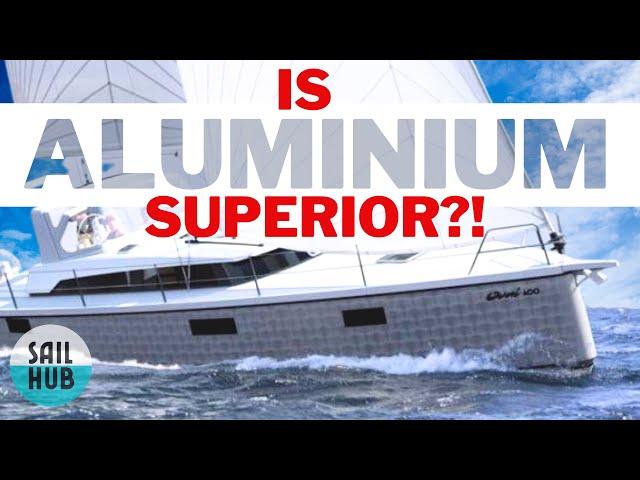
The truth about Aluminium sailing boats from a PRO. Hull Material series Pt. 3
Комментарии:

Looks like Taryn & Logan have never heard of aluminium. They act like there is only steel vs fiber glass...
Ответить
Doesn't matter what a boat is built from, it seems most owners can't afford or don't want to maintain them. Have a look at the majority of boats for sale, poorly maintained the lot of them.
Ответить
Steel is easy to get by and reasonably easy to handle but it takes a lot of maintenance work.
Ответить
you did not cover stainless steel boats - why?
Ответить
No mention of Corten steel. A lot of Dutch boats use this, they are the masters. No real big rust problems. I looked at one, even had bare steel inside!
Ответить
The great thing about steel is that it really one has one failure mode - which usually makes itself obvious to the observant. In some ways rust is your friend because it's so easy to fix if you get onto it early. And metal boat are a lot more rigid and with proper attention to detail they will not leak. The bilges should be dust dry and clean.
The best tip I know is to try and keep as much of the wiring and plumbing out of the bilge as possible so that it is easy to clean out with detergent and fresh water hosing once a year or so. Keep the the bilge clean, the paint will remain solid and it will not rust.
Never let wet timber sit against the steel. It will destroy the paint.
Pay attention to dissimilar metals, particularly welds to 316 components. These days you can probably use other synthentic materials instead.
Do these three things and 90% of the root causes of rust on a steel boat will be sorted - the other 10% is just routine maintenance of chips and no more onerous than any other material to maintain,

They made sense back then why not now did the ocean decide to change it's mind all of a sudden????????
Ответить
Ferro Concrete the only way to go for an adventure/cruising boat. Highly under-rated and stronger than steel.
Ответить
what about if one generously applies a few coats of primer and added polyurea on top of that, inside and out, would that not be a massive game changer ?
Ответить
The weight to price ratio of steel versus aluminium is positive for aluminium (weight difference 5x)with the added positive effect that aluminium is lighter. Steel might be better if build correctly in iceberg filled waters but proper aluminium yachts can be good also there. (aluminium can be welded MIG TIG also by the way) Biggest advantage offcourse in the cost departement is that aluminium does not need paint...So in the long run aluminium gets to be even cheaper versus steel.
Ответить
I take a metal boat over a plastic one
Ответить
Last thing I would want is a wood boat add plastic and wood together run, run, run!
Ответить
Might be easy to get steel etc to do hull repairs, but what you forgot to mention is there are alot of boat yards that dont allow hot work, ie grinding and welding steel.
Ответить
What about stainless crunching the numbers
Ответить
what about a boat made from rost free steel?
Ответить
I have owned one steel yacht and one grp yacht. My next yacht will be steel.
Ответить
Re: all titanium sailing yacht
See the You Tube video about the Japanese 40’ all titanium sailing yacht.😊

are you Italian? no , then stop talking with your hands , ( right at the beginning )... it spoils the video
Ответить
the Titanic was Steel ... still sunk
Ответить
Steel, my choice for a bluewater boat.
Ответить
Definitely, yes.
Ответить
Then you should check Yelkovan 56.
Ответить
OK, as an Engineer, you cannot beat steel for durability. if you looking at purchasing one id very much recommend buying one based on a survey. Buy a steel thickness measuring tool as it will tell you the thickness of the material then you can make an informed decision if it has rust in the bowels or not very easily! if it shows it has then you will need to strip the inside to get at the corrosion properly and that takes time but due diligence before you buy is money well spent going forward. Hope this helps😅
Ответить
Ya, know?
I've seen a lot of boat channels.
Lots, of boat channels.
And a lot of different hosts.
But this brunette, who is (hosting?)
this channel?
Comes across as very, very, dim.
Very, very, dim.
Yikes.

Looking a steel hull boat 50 to 70 ft to rescue with a ceramic coating for a before and after .
Ответить
The "expert" doesn't know what a chine is. He's a clueless idiot.
To clarify: A hard chine hull is a hull with only a single chine; It's called a hard chine because it is a more obvious and significant angle change in shell plating than in double-chine or multi-chine. His statements about hard chine were completely clueless and spreading disinformation to potential newcomers.

You’ve never sailed through heavy ice and it shows.
Ответить
Look up Emerald Steel, a self built steel yacht built a long time ago, and still going strong.
Ответить
Put a sacrificial anode of zinc to help
Ответить
Well if you want the real technical answer. Steel doesn't make much sense for small pleasure boats, because marine steel is no stronger than marine aluminium, but 3 times heavier. It's more expensive but that price difference will be negligible for a small boat that might only use 5-10t of it. Fabrication of the boat and sails/rigging/engines/gadgets/interiors dwarfs the cost of raw materials.
However on a massive commercial ship strength to weight is less important and raw material costs are more significant. In addition steel has an infinite fatigue life - it will degrade in strength to a point, but no further, whereas aluminium and glass fibres will get weaker and weaker and weaker forever with every wave cycle - of course they'll still last a very long time, but commercial steel hulls working day after day after day can in theory last forever - with the right care.

It depends on what you want to do with your boat. Going through the bering sea during the winter in a grp hull will result in you sinking. It's not if, it's when. You go into the arctic in grp your boat will shatter. In aluminium? Your hull will twist and deform.
Ответить
I had a steel sail boat for 17 years and it was the best vessal i,ve ever owed at 5r ft.
Ответить
i bought a steel boat, because its easy to fix for me. angle grinder and welder is all i need.
Ответить
Its all about maintaining high quality 2 part epoxy paint topside and below the waterline and regular zink replacement. No oxygen = no rust
Ответить
I have had both… fibreglass boats are noisy and flex way too much. Further to this they crack easily which over time allows water ingress which delaminates the structure. My 55’ Steel beast weighs 22ton loaded, is fully insulated for hot and cool climates, cruises at 7knots plus and I have never needed to do maintenance work on her 32year hull; ever. And no condensation : in fact she doesn’t have a bilge pump… go figure! She is considered a Dry Boat design. Steel yacht owners tend to be more relaxed yachties…
Ответить
Taryn and Logan may be great steel workers and their description of issues with steel as a boat building material is very good. It seems to me though, that they are not as experienced with fiberglass as they portray it as a material from hell ;-) As a guy who worked for years in fibreglass repair and construction, I assure you, it is not half as bad as they describe it. You get used to itching after a month or so and also you learn to protect your skin and lungs against the fibres and the chemicals. It is a non issue. Steel has one problem for me they did not quite stress enough - it is almost impossible to make a steel hull decent looking. Creating compound curvature is all but impossible without a lot of money and steel is so hard that even keeping it straight and flat is a chalange, especially if you are doing it with basic tooling. Most steel boats look like s--t ;-)
Ответить
Owning a steel boat I contribute the following...
They can be the best or the worst boat you can own. Steel is often the building material of amateur builders. This is not a good or bad thing. But something to be keenly aware of. Build quality varies significantly and resale value is less than a comparable production boat.
Whether corrosion will be a big issue boils down to surface preparation and coatings. The best coatings are useless on an improperly prepared surface. "Properly" means professionally sandblasted to white metal. For exterior surfaces, this is enormously laborious and expensive but doable. However, steel boats normally rust from the inside out. And stripping the interior of a sizeable boat to bare steel for expensive sandblasting and coatings and a complete interior refit is an understandable deal breaker for sensible folk.
Welding...
It's not making two pieces of metal stick together. Do not think you can replace hull plating, frame or stringer sections, sea chests, standpipes, etc. without being trained and having significant experience (practice) welding less critical applications first. Welding is Not easy to do correctly and it's Much more difficult on thin steel. Anyone can get decent, if not porous, results on 3/8" plate. Water or fuel tight welds on 1/8" plate is an entirely different story.
Welding will also affect surrounding areas. Let's say you want to weld something on a frame. You're very likely to burn the coatings and fairing on the outside of the hull too. So it's not as easy as a little grinding and painting around the weld area on the interior.
I don't want to scare anyone away from steel boats. I love mine. They're not colder or hotter than a fiberglass boat. Both need insulation. As boats scale up steel is lighter than fiberglass. It bends rather than breaking. Steel boats and often less prone to leaks as deck fittings can be welded on rather than fastened. Need less, if any, structural bulkheads. Chainplate leakage isn't an issue as they too are welded. No coring to rot. There are indeed many advantages.
Another consideration is asthetics. Welded plate warps. Fairing will almost certainly be required. Depending on the builder, it can be a significant amount. (I spent two years plus fairing my 38' hull from toerail to the bottom of the keel.)
Remember, commenters are just that. So take them, and mine, with a grain or pound of salt as the comment warrants.

HMS Belfast was built of steel and launched in 1938. She is still happily afloat today.
How many fibreglass boats have been blown up by a mine, got pack to port, have been repaired and are still afloat?

Would be great if you could hot dip galvanise the hole boat
Ответить
Presenter is very irritating she's continuously throwing her arms at the camera.
Ответить
Really good, realistic advice. Thank you.
Ответить
If i owned a steel boat, i would want one of those rust burning lasers and a good quality sand blaster for sure
Ответить
What steel? You need hi carbon steel with resistance to corrosion (chromium copper alloy type Coreten. You are ignorant fools. Welcome to U tube my friemds.
Ответить
Good vid!
Ответить
We need to make titanium cheaper. It might be the greatest option
Ответить
Have hit the bottom in a shallow bar,broke bottles in the cupboards,no other damage,would have snapped keel bolts and possibly sunk the boat if it wasn’t steel.
Ответить
Being 62 I don't care about the material. Also don't buy green bananas anymore
Ответить
This girl isn’t moving her arms and hands enough hahaha
Ответить
How about Corten steel?
Ответить




![[BTN클래식]송강스님과 함께하는 불교 기초 배우기 - 187편 부처님의 생애와 가르침 2. '이 세상에 태어나심' [BTN클래식]송강스님과 함께하는 불교 기초 배우기 - 187편 부처님의 생애와 가르침 2. '이 세상에 태어나심'](https://rtube.cc/img/upload/a0dhSEt2T0UxbmE.jpg)





![[2/22] KongKong [2/22] KongKong](https://rtube.cc/img/upload/Y1FfZEpvVGNjU2k.jpg)














